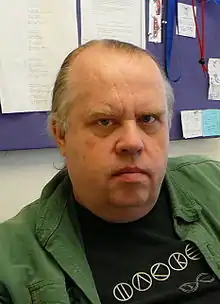Tom Duff
Thomas Douglas Selkirk Duff (born December 8, 1952) is a computer programmer.

Early life
Duff was born in Toronto, Ontario, Canada, and was named for his putative ancestor, the fifth Earl of Selkirk. He grew up in Toronto and Leaside. In 1974 he graduated from the University of Waterloo with a B.Math and, two years later, was awarded an M.Sc. from the University of Toronto.
Career
Duff worked at the New York Institute of Technology Computer Graphics Lab and the Mark Williams Company in Chicago before moving to Lucasfilm's Computer Research and Development Division. He and Thomas Porter, another Lucasfilm employee, developed a new approach to compositing images; their 1984 paper, "Compositing Digital Images",[1] is "[t]he seminal work on an algebra for image compositing", according to Keith Packard.[2] and "Porter-Duff compositing" is now a key technique in computer graphics. (See, for example, XRender and Glitz.)
Duff later worked for 12 years at Bell Labs Computing Science Research Center, where he worked on computer graphics, wireless networking, and Plan 9;[3] in the course of his work there, he authored the well known "rc" shell for the Version 10 Unix operating system.
Duff has worked at Pixar Animation Studios since 1996.
Achievements
- In 1995, he was awarded (with others) the Academy Scientific and Engineering Award for his work on digital image compositing. With Bill Reeves he designed the first version of Pixar's Marionette 3-D animation system, which won the same award in 1997.
- While working at Lucasfilm, he created Duff's device, a loop unrolling mechanism in C.
- On August 22, 2006, the United States Patent and Trademark Office issued U.S. Patent 7,095,409 to Pixar for a "Shot shading method and apparatus" invented by Tom Duff and Robert L. Cook.
- On October 31, 2006, the United States Patent and Trademark Office issued U.S. Patent 7,129,940 to Pixar for a "Shot rendering method and apparatus" invented by Tom Duff and Robert L. Cook.
- In 2015 he became the 21st awardee of the J.W. Graham Medal, named in honor of Wes Graham an early influential Professor of Computer Science at the University of Waterloo, and annually awarded to an influential alumnus of the University's Faculty of Mathematics.[4]
Quotes
- "Shared libraries are the work of the devil, the one true sign that the apocalypse is at hand."[5]
- "Nobody really knows what the Bourne shell's grammar is. Even examination of the source code is little help."[6]
- "π seconds is a nanocentury."
Appearances
- Tom Duff makes a cameo appearance in the Niven/Pournelle science fiction novel Footfall as a co-discoverer of the invading spaceship: "Chap named Tom Duff, a computer type, spotted it."
- Tom Duff appears briefly in the documentary film "Noisy People" (dir Tim Perkis, 2006) playing the banjo.[7]
See also
- Mothra — a Web browser Tom Duff wrote for Plan 9
- Duff's device — a C programming language trick attributed to Tom Duff
- List of people by Erdős number — Duff has an Erdős number of 2[8][9]
- List of Pixar staff
References
- Porter, Thomas; Tom Duff (1984). "Compositing Digital Images". Computer Graphics. 18 (3): 253–259. doi:10.1145/800031.808606. ISBN 978-0-89791-138-2. S2CID 18663039.
(Available at pixar.com.) - Keith Packard's webpage about Porter & Duff's 1984 paper
- http://lambda-the-ultimate.org/node/295#comment-2531
- "Recipients of the J.W. Graham Medal in Computing & Innovation". University of Waterloo. Retrieved 2015-09-25.
- Duff, Tom. "Re: [9fans] SO for plan9?". 9fans (Mailing list). Archived from the original on September 29, 2007. Retrieved December 17, 2006.
- Duff, Tom. "Rc — The Plan 9 Shell". Cite journal requires
|journal=(help) - http://noisypeople.perkis.com
- N.J.A. Sloane, R.H. Hardin, T.S. Duff, J.H. Conway: "Minimal-Energy Clusters of Hard Spheres", Discrete & Computational Geometry 14, No. 3, 237–259, 1995.
- J.H. Conway, H.T. Croft, P. Erdos, M.J.T. Guy: "On the Distribution of Values of Angles Determined by Coplanar Points", J. London Math. Soc., II., Ser. 19, 137–143, 1979.
External links
- Tom Duff (short cv on family web site)
- iq0 (personal web site)
- rc - The Plan 9 Shell
- A Quick Introduction to the Plan 9 Panel Library, a GUI toolkit by Tom Duff
- Tom Duff "Viral Attacks On UNIX System Security", AT&T 11273-880728-02TMS, August 1987